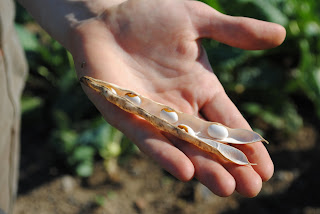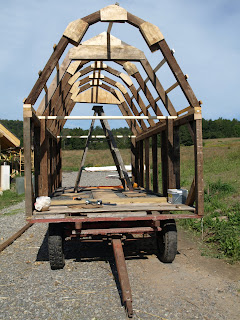
Over the last two years a few men have come courting our scrap metal. I don't know how any of them knew what was hidden in the deepest, darkest pockets of our woods. Even I haven't seen the second pile, a crescendo of tires and old cars cascading over a steep bank. People know people, and word gets around, I suppose. Most of these offers have come and gone in vain. Either the scrapper loses interest, or the fields are too wet to go scavenging in when the offer is made. We had told one guy that he could have everything, as long as he was willing to dig it out. But, his offer came after heavy rains and again, it fell through. This time it's different.

Two men approached Edmund offering to haul everything away and split the profit with us 50/50. We talked it over at dinner and everyone agreed it was a fine idea. To our surprise the guys called us on the phone the next day to seal the deal. No scrapper has ever been this tenacious. We gave them the go ahead and the two of them showed up a day later. They jumped on our pile of truck axels and hog fencing with a mammoth saw and had everything in manageable pieces within a few hours. They came back to us with a receipt and $300 in cash.

Because they haul so much volume, they were offered a dumpster from the scrap metal place and were able to lock in a better price per ton than other people get who bring it all in truckloads. When the dumpster arrived an hour after we agreed to it (who are these guys?), we gave them permission to take all the metal in the barn: head gates, drinking tubs, industrial fans, the manure trough mechanism and the hay elevator. A few other characters have showed up to help with the whole ordeal. It strikes me as a lot of work for a small profit, split between four men, but they are obviously into it. One of them has a very small dog. After getting permission to bring the animal along, he yelled coarsely through the cigarette in his mouth, "Rocky! Get in here! It's time to rocky roll!"
Edmund and Normandy have begun building the walls of their house out of cob (a mixture of clay, sand and straw), and it's reminded me that we are as unusual to some people as they may be to us. These guys had never seen anyone do anything like that before. They said they mentioned it to a friend, that a guy they know is building his house out of dirt, "but if you want to see that you'll have to come junkin' with us."

The old cars have all been extricated from the weeds north of the stream. The only metal we've got left is that pile I haven't seen. We told them that if they took the tires, they could have all the cash they could render from that heap. I assume they'll be here to finish it off soon because the scrap place just delivered our third dumpster today.

I read something a few months ago about how the industrial age is phasing out, and how the next era's economy will be based on restoring or repurposing what's left over - relics from a time of seemingly infinite energy and resources. It certainly seems that way now.


-Alanna
















